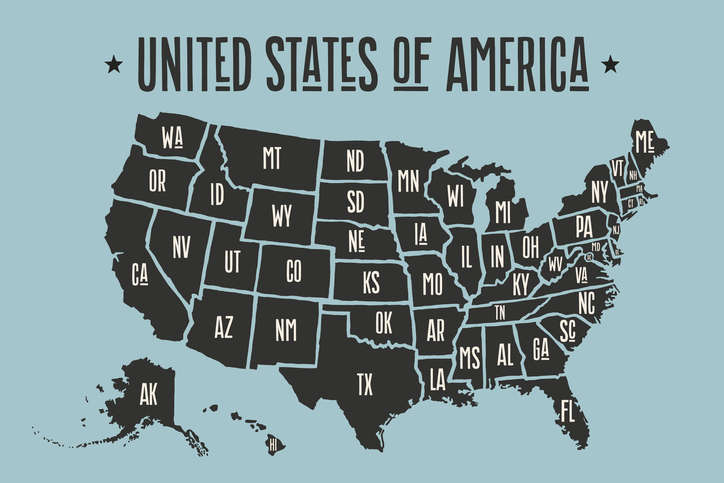USA State Abbreviations and State Postal Codes
| State/District | Abbreviation | Postal Code |
|---|---|---|
| Alabama | Ala. | AL |
| Alaska | Alaska | AK |
| Arizona | Ariz. | AZ |
| Arkansas | Ark. | AR |
| California | Calif. | CA |
| Colorado | Colo. | CO |
| Connecticut | Conn. | CT |
| Delaware | Del. | DE |
| District of Columbia | D.C. | DC |
| Florida | Fla. | FL |
| Georgia | Ga. | GA |
| Hawaii | Hawaii | HI |
| Idaho | Idaho | ID |
| Illinois | Ill. | IL |
| Indiana | Ind. | IN |
| Iowa | Iowa | IA |
| Kansas | Kans. | KS |
| Kentucky | Ky. | KY |
| Louisiana | La. | LA |
| Maine | Maine | ME |
| Maryland | Md. | MD |
| Massachusetts | Mass. | MA |
| Michigan | Mich. | MI |
| Minnesota | Minn. | MN |
| Mississippi | Miss. | MS |
| Missouri | Mo. | MO |
| Montana | Mont. | MT |
| Nebraska | Nebr. | NE |
| Nevada | Nev. | NV |
| New Hampshire | N.H. | NH |
| New Jersey | N.J. | NJ |
| New Mexico | N.M. | NM |
| New York | N.Y. | NY |
| North Carolina | N.C. | NC |
| North Dakota | N.D. | ND |
| Ohio | Ohio | OH |
| Oklahoma | Okla. | OK |
| Oregon | Ore. | OR |
| Pennsylvania | Pa. | PA |
| Rhode Island | R.I. | RI |
| South Carolina | S.C. | SC |
| South Dakota | S.D. | SD |
| Tennessee | Tenn. | TN |
| Texas | Tex. | TX |
| Utah | Utah | UT |
| Vermont | Vt. | VT |
| Virginia | Va. | VA |
| Washington | Wash. | WA |
| West Virginia | W.Va. | WV |
| Wisconsin | Wis. | WI |
| Wyoming | Wyo. | WY |
| Territory/Associate | Abbreviation | Postal Code |
|---|---|---|
| American Samoa | AS | |
| Guam | Guam | GU |
| Marshall Islands | MH | |
| Micronesia | FM | |
| Northern Marianas | MP | |
| Palau | PW | |
| Puerto Rico | P.R. | PR |
| Virgin Islands | VI |

The History of U.S. Postal Codes
The history of the post-service in the U.S. is long, complicated, and supremely important for westward expansion. But, a lot of people might not realize that postal codes are actually quite recent. What's more, the two-letter codes that people are familiar with today actually came after the invention of ZIP codes.
An Abbreviated Early History
The story starts in 1831–well before the states were given codes–with that year's Table of Post Offices in the United States. The Table was essential for people to figure out where they could send their mail and where it could be received back when they were expected to retrieve it themselves. In 1831 the Post Office Department included a list of acceptable state abbreviations to use when addressing letters. They preferred that people just write the full names, but people enjoyed the quicker and easier way of writing (just like today).
The Beginnings of the Modern Mail Service
President Abraham Lincoln (a former postman himself) was persuaded to begin free letter shipping in cities in 1863. This was the origin of the modern system of home letter deliveries. As mail carriers began taking more complicated and longer routes through the cities, the number of carriers grew. Due to the growing workforce, the admission of new states, and more interstate mail thanks to the likes of the Pony Express, the government sent out a new, bigger list of abbreviations in 1874. These would be the default codes until World War II.
When the war called away huge numbers of the country's young men, the post was seriously understaffed. The people who were left also weren't as familiar with the parts of town they didn't work in prior. The post offices began breaking down cities into broad numbered regions (like Birmingham 7, etc.) to narrow the field for carriers. This system proved effective and became de facto practice up until the release of the Postal Bulletin for June 1963. The bulletin introduced the ZIP Code as a fast and easy way of organizing mail. They also released new shorter state abbreviations to make room for ZIP codes on letters.
The Current System
But what about the postal codes? That same year, in October, came Publication 59. With it came the codes we have today. They were originally intended as optional tags for businesses but became standard for everyone over time. Since 1963 there has been only one change to the postal codes; in 1969, at the request of the Canadian government, the code for Nebraska was changed from NB to NE, to avoid confusion between Nebraska and New Brunswick.
In addition to the fifty states and D.C., the United States also holds several overseas territories. The populated ones have their own postal codes, but only the two most populous (Puerto Rico and Guam) have abbreviations. Some former territories still maintain postal codes, as they are considered free associates of the United States. The Marshall Islands, Micronesia, and Palau are all free associates. These are included on a second table below.
No comments:
Post a Comment